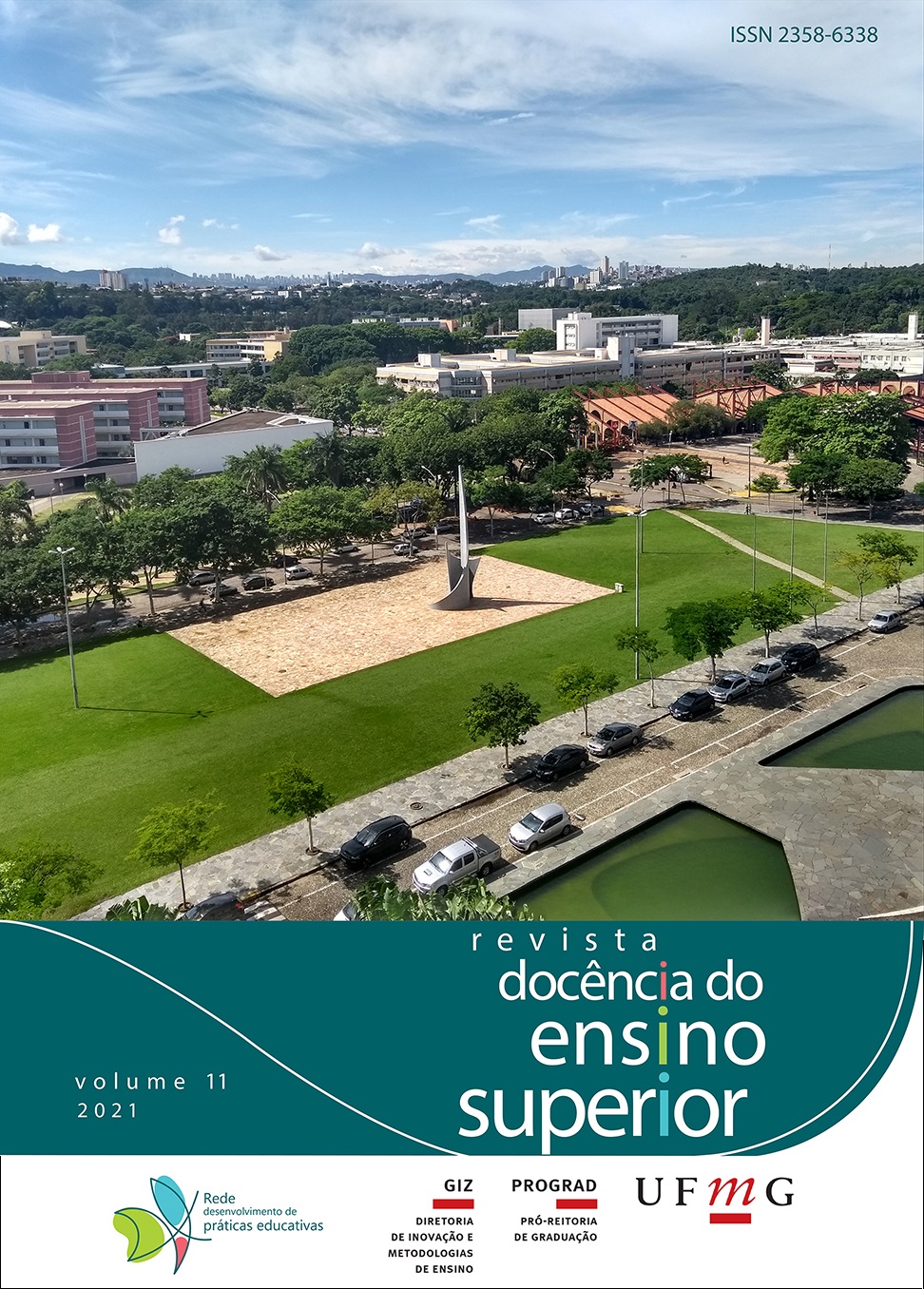¿Por qué los estudiantes universitarios experimentan estrés, ansiedad y depresión?
Una revisión rápida de estudios longitudinales
DOI:
https://doi.org/10.35699/2237-5864.2021.29593Palabras clave:
Ansiedad, Depresión, Estudiantes universitarios, Educación superior, Salud mentalResumen
Muchos problemas de salud mental comienzan o se agravan al ingresar a la universidad. El objetivo fue identificar factores relacionados con el estrés, la ansiedad y la depresión en estudiantes universitarios a partir de estudios longitudinales. Se realizó una revisión de las bases de datos: Medline, Web of Science, SCOPUS y PsycInfo. También se realizó una búsqueda adicional en los primeros cien resultados de Google Scholar y en las referencias de los artículos elegibles. Se identificaron dos grupos de factores: 1) ambientales/sociales: experiencias adversas en la infancia, fragilidad de las relaciones sociales y tiempo de exposición a los medios electrónicos; 2) personal: creencias sobre uno mismo, incapacidad para modificar atributos propios, rasgos de personalidad y cogniciones disfuncionales combinadas con eventos estresantes. Se concluyó que el conocimiento de las causas es importante para identificar a los estudiantes en riesgo y planificar acciones que incentiven la búsqueda de ayuda y el desarrollo de habilidades para el manejo del estrés.
Descargas
Citas
AMERICAN PSYCHIATRIC ASSOCIATION. Manual Diagnóstico e Estatístico de Transtornos Mentais. 5. ed. Porto Alegre: Artmed, 2014.
ARAÚJO, Crislaine Luisa; BRESSAN, Vânia Regina. Ações de promoção à saúde, atenção psicossocial e educacional como práticas de integração universitária. In: CONFERENCIA LATINOAMERICANA SOBRE ABANDONO EN LA EDUCACIÓN SUPERIOR, 7., 2017, Córdoba. Anais [...]. Córdoba: Universidad Nacional de Córdoba, 2017. Disponível em: https://revistas.utp.ac.pa/index.php/clabes/article/view/1618. Acesso em: 14 abr. 2021.
ARENAS, Daniel Luccas et al. Pega Leve – Saúde mental do estudante universitário: um relato de experiência. Trabalho (En)Cena, Palmas, v. 4, n. 2, p. 519-530, 2019.
AUERBACH, Randy Patrick et al. WHO World Mental Health Surveys International College Student Project: prevalence and distribution of mental disorders. Journal of Abnormal Psychology, Washington, v. 127, n. 7, p. 623-638, 2018. DOI: https://doi.org/10.1037/abn0000362.
BELASCO, Isabel Cristina; PASSINHO, Renata Soares; VIEIRA, Valéria Aparecida. Práticas integrativas e complementares na saúde mental do estudante universitário. Arquivos Brasileiros de Psicologia, Rio de Janeiro, v. 71, n. 1, p. 103-111, 2019. DOI: https://dx.doi.org/10.36482/1809-5267.ARBP2019v71i1p.103-111.
BETTIS, Alexandra H. et al. Comparison of two approaches to prevention of mental health problems in college students: enhancing coping and executive function skills. Journal of American College Health, v. 65, n. 5, p. 313-322, 2017. DOI: https://doi.org/10.1080/07448481.2017.1312411.
BILEVICIUS, Elena et al. Shame mediates the relationship between depression and addictive behaviours. Addictive Behaviors, v. 82, p. 94-100, 2018. DOI: https://doi.org/10.1016/j.addbeh.2018.02.023.
BURKE, Anne S. et al. Rationale, methods, feasibility, and preliminary outcomes of a transdiagnostic prevention program for at risk college students. Frontiers in Psychiatry, v. 10, p. 1030, 2019. DOI: https://doi.org/10.3389/fpsyt.2019.01030.
DRAKE, Emily C.; SLADEK, Michael R.; DOANE, Leah D. Daily cortisol activity, loneliness, and coping efficacy in late adolescence: a longitudinal study of the transition to college. International Journal of Behavioral Development, v. 40, n. 4, p. 334-345, 2016. DOI: https://doi.org/10.1177%2F0165025415581914.
DROUIN, Michelle et al. College students in distress: can social media be a source of social support. College Student Journal, Alabama, v. 52, n. 4, p. 494-504, 2018.
EBERT, David D. et al. Prediction of major depressive disorder onset in college students. Depression and Anxiety, v. 36, n. 4, p. 294-304, 2019. DOI: https://doi.org/10.1002/da.22867.
FISKE, Abigail; HOLMBOE, Karla. Neural substrates of early executive function development. Developmental Review, v. 52, p. 42-62, 2019. DOI: https://doi.org/10.1016/j.dr.2019.100866.
GANANN, Rebecca; CILISKA, Donna; THOMAS, Helen. Expediting systematic reviews: methods and implications of rapid reviews. Implementation Science, California, v. 5, n. 56, 2010. DOI: https://doi.org/10.1186/1748-5908-5-56.
HE, Yini et al. Levels of neuroticism differentially predict individual scores in the depression and anxiety dimensions of the tripartite model: a multiwave longitudinal study. Stress and Health, v. 34, n. 3, p. 435-439, 2018. DOI: https://doi.org/10.1002/smi.2803.
KARATEKIN, Canan. Adverse Childhood Experiences (ACEs), stress and mental health in college students. Stress and health, v. 34, n. 1, p. 36-45, 2018. DOI: https://doi.org/10.1002/smi.2761.
KUJAWA, Autumn et al. Altered development of amygdala-anterior cingulate cortex connectivity in anxious youth and young sdults. Biological Psychiatry: Cognitive Neuroscience and Neuroimaging, California, v. 1, n. 4, p. 345-352, 2016. DOI: https://doi.org/10.1016/j.bpsc.2016.01.006.
LEÃO, Andrea Mendes et al. Prevalência e fatores associados à depressão e ansiedade entre estudantes universitários da área da saúde de um grande centro urbano do Nordeste do Brasil. Revista Brasileira de Educação Médica, Brasília, v. 42, n. 4, p. 55-65, 2018. DOI: https://dx.doi.org/10.1590/1981-52712015v42n4rb20180092.
LIU, Huijun et al. Gender differences in the influence of social isolation and loneliness on depressive symptoms in college students: a longitudinal study. Social Psychiatry and Psychiatric Epidemiology, London, v. 5, p. 1-7, 2019. DOI: https://doi.org/10.1007/s00127-019-01726-6.
MARTIN, Rebecca E.; OCHSNER, Kevin N. The neuroscience of emotion regulation development: implications for education. Current Opinion in Behavioral Sciences, v. 10, p. 142-148, 2016. DOI: https://doi.org/10.1016/j.cobeha.2016.06.006.
MCLAFFERTY, Margaret et al. Mental health, behavioural problems and treatment seeking among students commencing university in Northern Ireland. PLOS ONE, San Francisco, v. 12, n. 12, e0188785, 2017. DOI: https://doi.org/10.1371/journal.pone.0188785.
MURIS, Peter; MEESTERS, Cor; VAN ASSELDONK, Mike. Shame on me! Self-conscious emotions and big five personality traits and their relations to anxiety disorders symptoms in young, non-clinical adolescents. Child Psychiatry and Human Development, v. 49, n. 2, p. 268-278, 2018. DOI: https://doi.org/10.1007/s10578-017-0747-7.
PEDRELLI, Paola et al. College students: mental health problems and treatment considerations. Academic Psychiatry, v. 39, n. 5, p. 503-511, 2015. DOI: https://dx.doi.org/10.1007%2Fs40596-014-0205-9.
PIMENTA, Gisele. Felicidade se estuda na faculdade. UnB Notícias, 2018. Disponível em: https://noticias.unb.br/67-ensino/2392-felicidade-se-estuda-na-faculdade. Acesso em: 14 abr. 2021.
PORTER, Andrew C. et al. Self-evaluation and depressive symptoms: a latent variable analysis of self-esteem, shame-proneness, and self-criticism. Journal of Psychopathology and Behavioral Assessment, v. 41, n. 2, p. 257-270, 2019. DOI: https://psycnet.apa.org/doi/10.1007/s10862-019-09734-1.
SCHRODER, Hans S. et al. The fixed mindset of anxiety predicts future distress: a longitudinal study. Behavior Therapy, v. 50, n. 4, p. 710-717, 2019. DOI: https://doi.org/10.1016/j.beth.2018.11.001.
SEDERER, Lloyd I. The social determinants of mental health. Psychiatric Services, v. 67, n. 2, p. 234-235, 2016. DOI: https://doi.org/10.1176/appi.ps.201500232.
SHIM, Ruth et al. The social determinants of mental health: an overview and call to action. Psychiatric Annals, v. 44, n. 1, p. 22-26, 2014.
SONG, Yuqing et al. Incidence and risk factors of depressive symptoms in chinese college students. Neuropsychiatric Disease and Treatment, v. 16, p. 2449-2457, 2020. DOI: https://doi.org/10.2147/NDT.S264775.
STEPHANOU, Katerina et al. Hard to look on the bright side: neural correlates of impaired emotion regulation in depressed youth. Social Cognitive and Affective Neuroscience, v. 12, n. 7, p. 1138-1148, 2017. DOI: https://dx.doi.org/10.1093%2Fscan%2Fnsx039.
UNIVERSIDADE DE BRASÍLIA. Núcleo de Apoio Psicopedagógico e Bem Estar do Estudante de Medicina. Regimento do NAPEM/UnB da Faculdade de Medicina. Brasília: NAPEM/UnB, 2014. Disponível em: http://fm.unb.br/graduacao/nucleos/nucleo-de-apoio. Acesso em: 14 abr. 2021.
VANTIEGHEM, Michelle R.; TOTTENHAM, Nim. Neurobiological programming of early life stress: functional development of amygdala-prefrontal circuitry and vulnerability for stress-related psychopathology. In: VERMETTEN, E.; BAKER, D.; RISBROUGH, V. (ed.). Behavioral Neurobiology of PTSD. New York: Springer, 2018. p. 117-136. Current Topics in Behavioral Neurosciences, v. 38. DOI: https://doi.org/10.1007/7854_2016_42.
WU, Xiaoyan et al. Impact of screen time on mental health problems progression in youth: a 1-year follow-up study. BMJ Open, v. 6, n. 11, e011533, 2016. DOI: http://dx.doi.org/10.1136/bmjopen-2016-011533.
XIAO, Jing et al. “Weakest Link” as a cognitive vulnerability within the hopelessness theory of depression in chinese university students. Stress and Health, v. 32, n. 1, p. 20-27, 2016. DOI: https://doi.org/10.1002/smi.2571.
Descargas
Publicado
Cómo citar
Número
Sección
Licencia
Derechos de autor 2021 Thaís Branquinho Oliveira Fragelli, Ricardo Ramos Fragelli

Esta obra está bajo una licencia internacional Creative Commons Atribución 4.0.
Los autores que publican en esta revista conservan los derechos de autor y otorgan a la revista el derecho de primera publicación, siendo la obra licenciada simultáneamente bajo la Creative Commons Attribution License, que permite compartir la obra con reconocimiento de autoría y publicación inicial en esta revista.
Los autores están autorizados a asumir contratos adicionales por separado, para la distribución no exclusiva de la versión del trabajo publicado en esta revista (por ejemplo, publicación en un repositorio institucional o como capítulo de libro), con reconocimiento de autoría y publicación inicial en esta revista.
Política de acceso abierto:
La Revista Docência do Ensino Superior es una revista de Acceso Abierto, lo que significa que todo el contenido está disponible de forma gratuita, sin costo para el usuario o su institución. Los usuarios pueden leer, descargar, copiar, distribuir, imprimir, buscar o vincular a los textos completos de los artículos, o utilizarlos para cualquier otro propósito legal, sin necesidad de obtener el permiso previo del editor o autor, siempre que respeten la licencia de uso. los Creative Commons utilizados por la revista. Esta definición de acceso abierto está en línea con la Iniciativa de Acceso Abierto de Budapest (BOAI).
























